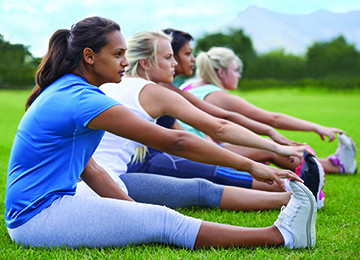There aren’t many people walking around that haven’t had or are experiencing back pain. It can be debilitating, irritating and downright depressing. This is mostly due to our sedentary lifestyle. So what causes it and how can you fix it?
Neuroscience has shown that the brain creates pain to protect us. For chronic pain, the pain system becomes highly sensitive.
Our body LEARNS pain — and so we feel it more acutely.
When dealing with chronic pain, the brain is being overly cautious. Pain is increased by fear of re-injury and a whole host of other factors. And so, over time, our body creates a bigger
than necessary pain buffer zone. Exercise is one tool that can prevent and provide relief for lower back pain.
“If we can appreciate that pain is a protective device, not a measure of tissue damage. If we can communicate that to people, then we change the game,” Prof Moseley said. Yes, even if it hurts. Once you have the all clear from a doctor or physio, you are safe to move.
When people realise they are safe to move, they can start to get better, he said. When you stop moving, you get stiff and weak. This causes more harm during most rehab and recovery processes. Moving into a little bit of pain, usually between 2-3 out of 10, is generally appropritate.

What causes back pain?
Back pain is generally either acute or chronic. Most are from a minor strain of a muscle, ligament or the facet joints in the spine [the ones that allow you to twist and bend]. Luckily, there’s a lot you can do to prevent injuries.
Psychology and how to rethink your pain
Language is very important to our mindset and mentality. Language to describe pain such as — “feels like a knife” and “there’s something burning” — adds to how you experience pain. Most advertising uses language like attacking and fighting pain. This triggers a fight or flight response where we tense and prepare for battle. This is the complete opposite to how we want to make progress.
Moseley is leading the Pain Revolution movement, and wants people to understand — that pain is a friend that protects us when needed. But it can be like a mum and dad with their 15yr old child. A little over-protective sometimes. Understanding this is very important. By changing your outlook, by letting go of fear, your body can also let go and reset.
We need to retrain our pain system by slowly introducing movement back into our daily lives after injury.

Who can help?
Find the right professional. Every professional has their own expertise and their own experience. They need to be up to date with the current research and evidence and actively implementing strategies with their clients. In saying that, experience counts for a lot, and often the older practitioner who has been doing it for four decades will have done and seen things few others would have. Some might call it magic, others might just call it experience. Beware the practitioner who is stuck in their ways though. They can be sub-optimal.
To ensure you’re on the right path, we recommend osteo, physio and chiro (not necessarily in that order) based on the issue. If they want to see 3 or 4 times a week without a plan, this should be a red flag.
The days of ordering rest are gone for most rehab. If the practitioner is recommending injections and drugs, this should be a red flag. These are valid in some cases, but are very much over-prescribed. We are a fan of knowing, so if its bad enough, we like to get an appropriate scan. We have heard too many stories of people being treated for 6-months weekly, then going to get a scan and found out they were not even treating the problem. Should you run off and get a scan for every little thing? Absolutely not. But they can be helpful when serious enough. The old days of ordering bed rest are long gone, yet some clinicians still advise rest.
What are good ways to prevent or rehabilitate?
Most of us are living a sedentary lifestyle and spending many hours hunched over a computer. Improving your posture is going to have a big effect on your likelihood of developing back problems.
There’s a tonne of activities for back health. Pilates, Yoga and Strength and Conditioning. There doesn’t appear to be much strong evidence that one is superior as it really depends on the practitioner and your injury, but all can be helpful. It’s about having the right tools and guidance to suit you.
We recommend all our athletes to get a check-over from an allied health professional to ensure there are no underlying problems we have missed. Generally speaking, if there is no improvement 2-weeks after an acute onset of back pain, it’s definitely time to seek advice.
What type of exercise is right for you?


Where muscles around the spine are weak, strengthening them is key. It could be a movement pattern problem, which often ties in closely with mobility. That will require different exercises.
In terms of prevention, “There’s evidence that exercise reduces the rate of recurrence by 50 per cent. That’s a good reduction. Not a lot of medical treatments are that effective.”
Regularly stretching is a large piece of the puzzle. Start with 5min every day if that’s all you can manage. Do that for 2 weeks straight, and then double it to 10min. Continue to build until it becomes a daily habit. Movements like cat/cow, side lying thoracic extension and worlds greatest stretch are a few we love. Your spine needs to flex, extend, rotate and move laterally. Help it do what it was designed for.
Adding in strength work is also critical. Back injuries often occur from a weak trunk (core) so improvement in this area is very important. At least 3x30min per week of strength work with someone who knows what they are doing. Most people are scared of things like deadlifts, when they are a great tool to build strength. It’s generally poor technique and coaching that leads to injury from that front. Just doing planks daily doesn’t cut the mustard. The 4-point core, deadbugs, plank variations and hollow rock holds are great at isolating the trunk. In addition, we highly value exercises such as farmers carries, squats and deadlifts with the appropriate technique and bracing to improve functional strength.
In additions to moving, a few simple adjustments to your everyday life can include:
Review your desk space and office chair first and foremost.
Set up your keyboard to be in front of you when you are typing and leave a gap of around 10-15cm between the front of the desk and your keyboard. If there is not enough space between the desk edge and your keyboard then extra pressure can be put on joints and back muscles, which can lead to problems over time.
When it comes to your seated position, try not to slouch because this will increase tension in your muscles and lead to pain. Sit up straight by imagining a piece of string pulling you up from the top of your head, pulling your stomach in and drawing your
shoulders back at the same time. Getting into the habit of sitting this way might feel strange at first but it will help prevent problems in the long run.
